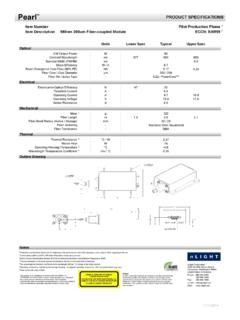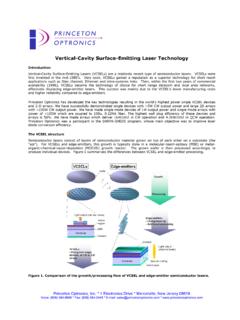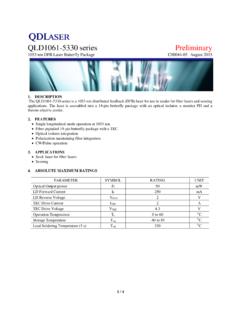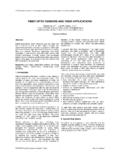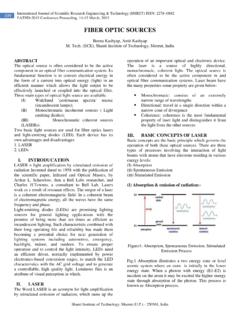Transcription of Laser Toner Fusion: An Imaging Process for …
1 Laser Toner Fusion: An Imaging Process for Graphic arts applications William Mey* and Dennis R. Kamp**. Torrey Pines Research* and NexPress Solutions LLC**. Rochester, New York Abstract paper, and lithographic printing plates as examples. The Process is insensitive to visible radiation and can be carried Laser - Toner -fusion (LTF) is a dry, high-quality out in ordinary roomlights. The images are robust to electrothermographic Imaging Process for producing images abrasion because the Toner image is partially buried in a from electronic input.
2 The Process steps involve using a thermoplastic layer. Binary halftone color separations have magnetic brush to apply a uniform Toner layer to a substrate, been made at 2540 pixels per inch resolution, and with a imagewise exposing the layer to a high power IR Laser , maximum UV transmission density of about ; the which tacks the Toner to the substrate, removing the ultimate resolution is limited by the Toner particle size. unexposed Toner using a magnetic brush Toner removal device and finally, fixing the image using conventional fusing.
3 The removed unexposed Toner can be recycled Process Overview thereby eliminating waste. The exposed Toner particles are partially buried in a thermoplastic layer and are therefore The LTF Process is schematically shown in Fig. 1 and robust to abrasion. The Process is insensitive to visible consists of four basic steps: (a) Toner laydown, (b) writing, radiation and can be carried out in ordinary roomlights. The (c) Toner removal, and (d) fusing. energy required for Imaging is between 150 and 300. mJ/cm2. The application most thoroughly investigated is imagesetting where color separations with 2540 pixels per inch resolution, and with transmission density of , have been made to produce high-quality 4-color images.
4 Keywords: electrophotography, electrography, Introduction Laser - Toner -fusion (LTF) is a dry, high-quality electrothermographic Imaging Process for producing images, on a variety of substrates, from electronic Presently, the major focus of LTF is on imagesetting, where high-quality monochrome color separations are made on a transparent substrate to expose lithographic plates for color printing. However, other applications , such as computer-to- Figure 1. LTF Process plate (CTP) and proofing have been investigated. This Process utilizes some of the technology found in First, a uniform layer of Toner is applied to a substrate electrophotography, such as toners, magnetic brush using a magnetic brush development station similar to those development, and fusing stations, while eliminating others found in conventional electrophotographic copiers and such as corona chargers, photoconductors, and Toner transfer printers.
5 The recording substrate must be somewhat stations. The Process uses electrostatics to apply a uniform conductive or backed by a conductive electrode. This blanket layer of dry-powder Toner onto a substrate, a high- conductivity is required in order to apply a uniform Toner power IR Laser to imagewise tack the Toner to the substrate, layer to the recording substrate, and to electrostatically hold a Toner removal device to remove all unexposed Toner the Toner particles in place after they are coated on the particles, and finally, thermal fusing to permanently fix the substrate.
6 The second step in the Process is writing using a image. One of the many advantages of LTF is the ability to high-power infrared Laser . Infrared radiation from the Laser record images on a variety of substrates including film, is absorbed by the carbon in the Toner particle causing an 1. instantaneous rise in temperature of several hundred degrees allows lower exposures for the migration of Toner particles centigrade, which softens the Toner particles (as well as the into the thermoplastic layer when heated imagewise. substrate) and "tacks" them to the substrate surface and to each other.
7 The partial imagewise melting of the Toner layer (and substrate) increases the surface forces thereby creating Developer a differential adhesive force between the exposed and The developer used in the Process is dual-component unexposed particles. Exposure can be delivered either (carrier plus Toner ) with the carrier consisting of "hard". incident upon the free surface of the Toner (front exposure) magnetic particles approximately 30 microns in diameter, or through the support side of the film (rear exposure), if and insulating non-magnetic Toner particles about 3 to 4.
8 Transparent, resulting in different Imaging properties. These microns in ,4 The Toner formulation incorporates a differences will be discussed in the section on Laser writing. carbon-based pigment along with a binder and charge agent. The third step in the Process is Toner removal. In the LTF In order to meet the Imaging demands of high transmission Process a very gentle magnetic brush,2 using "hard" density, Toner particles with a high percentage of carbon are magnetic carrier particles, is used to electrostatically and used.
9 These toners provide higher covering power, which mechanically remove the less tightly held unexposed allows for a reduction in Toner stack height and a subsequent particles. The exposed particles remain attached to the reduction in exposure. Pigment concentration of about 12%. substrate. The final step is fusing where the image is by weight is used in the LTF Process . Higher permanently fixed to the substrate. concentrations were tested but are limited by image artifacts such as pinholes. Also, at higher carbon concentrations, the unexposed Toner is more difficult to remove.
10 Materials Process Configuration Recording Substrate. A cross section of a typical film recording substrate used for imagesetting is shown in Fig. 2. Toner Laydown Toner laydown is accomplished by bias developing a uniform layer of Toner onto a grounded substrate using a magnetic brush development station. The Toner laydown station5 consists of a thin non-magnetic rotating stainless steel shell concentric with a rotating magnetic core. The rotational velocities of the shell and core can be independently controlled. The rotational direction and velocity depends upon the film velocity.

